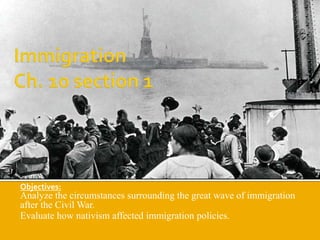
Immigration ch. 10.1
- 1. Objectives: Analyze the circumstances surrounding the great wave of immigration after the Civil War. Evaluate how nativism affected immigration policies.
- 2. By the late 1800s, most European states made it easy to move to America. • By 1900, eastern and southern Europeans made up more than half of all immigrants. • Of the 14 million immigrants who arrived between 1860 and 1900, many were European Jews.
- 3. Crossing America offered immigrants employment, few immigration restrictions, avoidance of military service, religious freedom, and the chance to move up the social ladder. Most immigrants took the difficult trip to America in steerage, the least expensive accommodations on a steamship.
- 4. The 14-day trip usually ended at Ellis Island, a small island in NewYork Harbor. It served as a processing center for most immigrants arriving on the East coast after 1892. • Most immigrants passed through Ellis Island in a day. • However, some faced the possibility of being separated from family and possibly sent back to Europe due to health problems.
- 5. Most immigrants settled in cities. • They lived in neighborhoods that were separated into ethnic groups. • Here they duplicated many of the comforts of their homelands, including language and religion. • Immigrants who learned English, adapted to American culture, had marketable skills or money, or if they settled among members of their own ethnic group tended to adjust well to living in the United States.
- 6. Severe unemployment, poverty, and famine in China; the discovery of gold in California; the Taiping Rebellion in China; and the demand for railroad workers in the United States led to an increase in Chinese immigration to the United States in the mid- 1800s. • InWestern cities, Chinese immigrants worked as laborers, servants, skilled tradesmen, and merchants. • Some opened their own laundries.
- 7. Between 1900 and 1908, large numbers of Japanese migrated to the United States as Japan began to build an industrial economy and an empire.The economy was unstable and many were dying in Japan’s Imperial wars. In 1910 a barracks was opened on Angel Island in California. Here, Asian immigrants, mostly young men and boys, waited sometimes for months for the results of immigration hearings.
- 8. The increase in immigration led to nativism, an extreme dislike for foreigners by native-born people and the desire to limit immigration. • Earlier, in the 1840s and 1850s, nativism was directed towards the Irish. • In the early 1900s, it was the Asian, Jews, and eastern Europeans that were the focus of nativism. • Nativism led to the forming of two anti-immigrant groups.
- 9. • The party’s founder, Henry Bowers, disliked Catholicism. • He wanted to stop Catholic immigration. APA propaganda depicting the Pope as the master decision-maker controlling the White House, Congress, and federal financial and publishing institutions. (Art from an 1894 book.) APA propaganda depicting the Pope as the master decision-maker controlling the White House, Congress, and federal financial and publishing institutions. (Art from an 1894 book.) APA propaganda depicting the Pope as the master decision-maker controlling the White House, Congress, and federal financial and publishing institutions. (Art from an 1894 book.) APA propaganda depicting the Pope as the master decision-maker controlling the White House, Congress, and federal financial and publishing institutions. (Art from an 1894 book.) APA propaganda depicting the Pope as the master decision-maker controlling the White House, Congress, and federal financial and publishing institutions. (Art from an 1894 book.) APA propaganda depicting the Pope as the master decision- maker controlling the White House, Congress, and federal financial and publishing institutions. (Art from an 1894 book.) APA propaganda depicting the Pope as the master decision-maker controlling the White House, Congress, and federal financial and publishing institutions. (Art from an 1894 book.)
- 10. As a result of heavy unemployment from the 1873-78 national depression, Denis Kearny, an Irish immigrant, organized the Workingman’s Party of California in 1877. This group wanted to stop Chinese immigration and end cheap Chinese labor. Racial violence resulted. This illustration depicts a Chinese man being kicked away from California, across the Pacific Ocean, and back into China by a giant Workingmen’s Party member.TheWorkingmen’s Party in California advocated for the removal of Chinese immigrants. Since Chinese workers were paid much less than white workers, they more likely to be chosen for work.TheWorkingmen’s Party called for the expulsion of Chinese Americans- “The Chinese must go!”This illustration shows the open hostility towards Chinese immigrants and the extent that political groups were organized to ensure that they leave America.
- 11. It barred Chinese immigration for 10 years and prevented the Chinese already in America from becoming citizens. This act was renewed by Congress in 1892, made permanent in 1902, and not repealed until 1943. For decades, Chinese Americans were affected. Shober & Carqueville produced this 1886 advertisement for a laundry detergent called the MagicWasher.